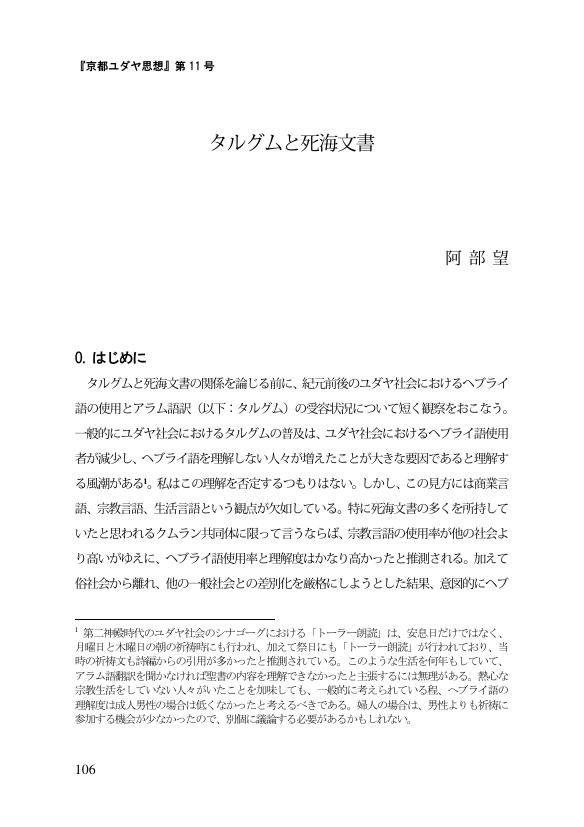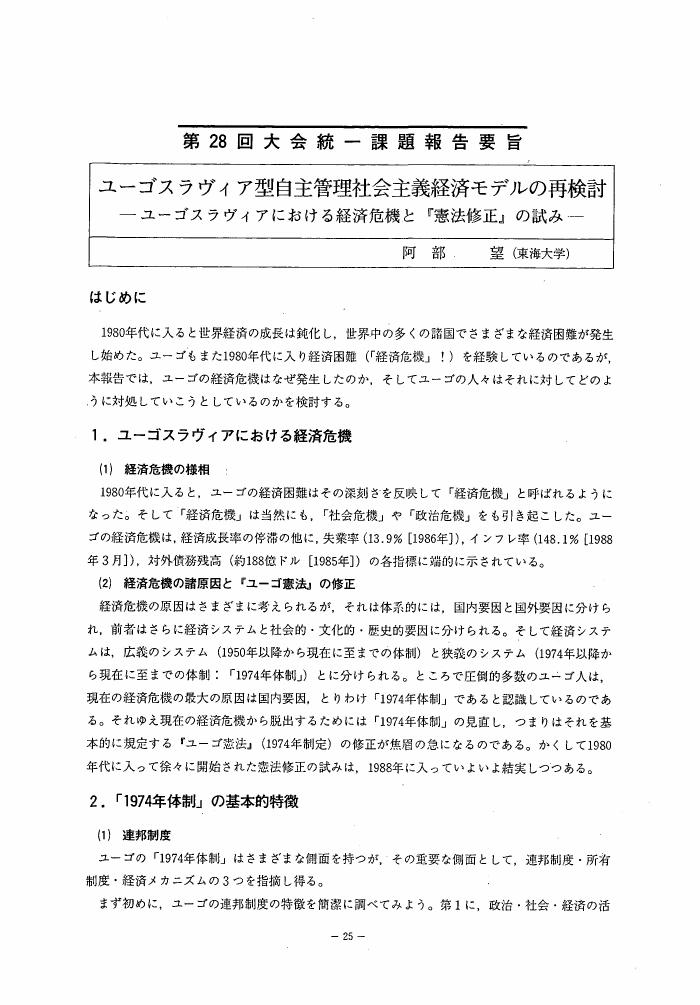2 0 0 0 OA 手術室における震災避難訓練
- 著者
- 金谷 明浩 山内 正憲 江島 豊 阿部 望
- 出版者
- 日本蘇生学会
- 雑誌
- 蘇生 (ISSN:02884348)
- 巻号頁・発行日
- vol.35, no.1, pp.23-26, 2016-04-01 (Released:2016-04-07)
- 参考文献数
- 4
東日本大震災後,病院危機管理の一つに震災対策が重要な位置を占めている。今回われわれは,手術中に発生した震度6の地震を想定した避難訓練を行った。隣接した2つの手術室で行い,参加したスタッフは医師,看護師,臨床工学技士,医療クラークを含め総勢32名であった。訓練担当看護師により災害発生時のフローチャートやシナリオが事前に説明された。今回の訓練ではアクションカードを用いた初期対応及び避難経路の確認,さらに,手術や麻酔覚醒の方針について震災状況を考慮して麻酔科医と外科医の間で協議してスムーズに決定することができた。手術室における災害訓練は必要不可欠であり,今後も継続して行うことが重要である。
2 0 0 0 IR 死海文書4Q274(4Q Tohorot A)の翻訳と注解
- 著者
- 阿部 望
- 出版者
- 獨協大学国際教養学部言語文化学科
- 雑誌
- マテシス・ウニウェルサリス = Mathesis universalis : bulletin of the Department of Interdisciplinary Studies (ISSN:13452770)
- 巻号頁・発行日
- vol.19, no.2, pp.83-100, 2018-03
2 0 0 0 IR 国際調査ジャーナリスト協会(ICIJ) 『世界の「水」が支配される!』
- 著者
- 阿部 望
- 出版者
- 明治学院大学国際平和研究所
- 雑誌
- PRIME = プライム
- 巻号頁・発行日
- no.23, pp.81-87, 2006-03
書評
1 0 0 0 OA タルグムと死海文書
- 著者
- 阿部 望
- 出版者
- 京都ユダヤ思想学会
- 雑誌
- 京都ユダヤ思想 (ISSN:21862273)
- 巻号頁・発行日
- vol.11, pp.106-121, 2020-12-20 (Released:2023-04-06)
1 0 0 0 OA EU加盟拡大と中東欧のアイデンティティー
- 著者
- 阿部 望
- 出版者
- ロシア・東欧学会
- 雑誌
- ロシア・東欧研究 (ISSN:13486497)
- 巻号頁・発行日
- vol.2005, no.34, pp.3-13, 2005 (Released:2010-05-31)
- 参考文献数
- 8
This paper examines how Central and Eastern European people identify themselves and what factors tend to influence their identities, based on data from the CCEB (Candidate Country Eurobarometer) series. The paper deals with several identity-related indicators, such as European Identity (EI), National Identity (NI), European Pride (EP), National Pride (NP) and EU Image (EI) . EI, a core indicator, shows much fluctuation from survey to survey and from country to country. Secondly, average EI scores show little difference between the ten Central and Eastern European countries (the CEE10) and the 15 EU countries (the EU 15) . This may imply that the people of the CEE10 identify themselves just as the people of EU10 do. Thirdly, concerning mutual relations between identity-related indicators, a strong positive correlation is observed between EP and NP. It is also observed between EU Image and Support for EU Membership, and between Support for EU Membership and Voting Behaviour in a Referendum. Finally, several economic fundamentals are examined as possible factors influencing EI. It turns out that the rate of inflation and the ratio of government fiscal deficit to GDP may influence EI to some extent.
1 0 0 0 OA 【共通論題2】いま、なぜ北ヨーロッパ研究か?
1 0 0 0 ポジティブ心理学:応用研究の最前線(3)
- 著者
- 企画代表者:島井 哲志企画者:堀毛 一也話題提供者:久保 信代 阿部 望 宇野 茂利指定討論者:島井 哲志 堀毛 一也司会者:島井 哲志 堀毛 一也
- 雑誌
- 日本心理学会第86回大会
- 巻号頁・発行日
- 2022-07-29
1 0 0 0 OA 強み介入が中学生の精神的健康に及ぼす効果に関する検討
- 著者
- 阿部 望 岸田 広平 石川 信一
- 出版者
- 一般社団法人 日本教育心理学会
- 雑誌
- 教育心理学研究 (ISSN:00215015)
- 巻号頁・発行日
- vol.69, no.1, pp.64-78, 2021-03-30 (Released:2021-05-01)
- 参考文献数
- 39
- 被引用文献数
- 4
本研究では,学校の実情に合わせた2つの強み介入を実施し,強み介入が中学生の精神的健康(生活満足度・抑うつ症状)に及ぼす効果について検討することを目的とした。研究1の強み認識・注目介入(自己や他者の強みを認識・注目させる介入)では中学3年生128名が対象であり,研究2の強み認識・注目・活用介入(自己や他者の強みを認識・注目させ,自己の強みを活用させる介入)では中学3年生87名が対象であった。分析の結果,研究1で実施した強み認識・注目介入は,生活満足度の向上に対してのみ効果があることが示唆された。一方,研究2で実施した強み認識・注目・活用介入は,生活満足度の向上と抑うつ症状の低減の両方に対して有効であることが示唆された。次に,効果的な強み介入の構成要素を探るために,介入の構成要素と対応する既存の強み変数の変化と精神的健康の変化の関連について探索的に検討した。その結果,強みの認識と他者の強みへの注目の変化が生活満足度の変化と正の関連を示し,強みの活用感の変化が抑うつ症状の変化と負の関連を示した。これらの結果から,生活満足度を向上させるためには強みの認識と他者の強みへの注目が重要であり,抑うつ症状を低減させるためには強みの活用が重要である可能性が示された。最後に本研究の課題と今後の展望について議論された。
- 著者
- 阿部 望
- 出版者
- 比較経済体制学会
- 雑誌
- 社会主義経済学会会報 (ISSN:18839789)
- 巻号頁・発行日
- vol.1988, no.26, pp.25-28, 1988-11-20 (Released:2009-07-31)
1 0 0 0 OA 旧ユーゴスラヴィア連邦の経済動向と体制転換(1992年) クロアチア共和国を中心として
- 著者
- 阿部 望
- 出版者
- 比較経済体制学会
- 雑誌
- 比較経済体制学会会報 (ISSN:18839797)
- 巻号頁・発行日
- vol.1993, no.31, pp.24-30, 1993-10-15 (Released:2009-07-31)
- 参考文献数
- 3
1 0 0 0 OA セルビア・モンテネグロにおけるEU加盟プロセスおよび経済体制移行の現状と問題点
- 著者
- 阿部 望
- 出版者
- Japan Association for Comparative Economic Studies
- 雑誌
- 比較経済体制学会年報 (ISSN:13484060)
- 巻号頁・発行日
- vol.42, no.2, pp.1-11,77, 2005-06-04 (Released:2009-07-31)
- 参考文献数
- 15
南東欧は将来EUへの加盟を確実視されているが,未だに多くの政治経済的な困難を抱え,EU加盟を果たしていない。本稿では南東欧の中でも特にセルビア・モンテネグロに焦点を当てて,EU加盟のプロセスと経済体制移行の問題点と展望とを考察する。本稿は,この国の特異な国家形態のゆえに既存の国際支援パッケージでは限界のあること,そしてコソボ問題の解決こそがこの国の発展にとって最重要な課題であることを主張する。
1 0 0 0 OA 死海文書4Q274(4Q Tohorot A)の翻訳と注解
- 著者
- 阿部 望
- 出版者
- 獨協大学国際教養学部言語文化学科
- 雑誌
- マテシス・ウニウェルサリス = Mathesis Universalis (ISSN:13452770)
- 巻号頁・発行日
- vol.19, no.2, pp.83-100, 2018-03
- 著者
- 阿部 望
- 出版者
- 東海大学
- 雑誌
- 東海大学紀要. 教養学部 (ISSN:03892018)
- 巻号頁・発行日
- vol.33, pp.23-58, 2003-03-30
The EU Summit held in June 2001, which is called the Gothenburg European Council, adopted the Sustainable Development Strategy (SDS) for the European Union. This Strategy, which is considered as a core factor of the EU policy as a whole, strongly requests the policy integration, which means that each sector policy should include the environmental, social and economic considerations into its contents. In this sense, the SDS provides a very comprehensive policy and shows a future direction of the EU policy making. Obviously the SDS is not an idea which was suddenly hit on by European politicians but has been gradually prepared and implemented in the EU. This paper examines the historical development of the SDS in the EU and clarifies what the SDS truly implies. Furthermore, it tries to assess how much the SDS and policy integration have been realised as was initially expected since the beginning of 1990. The findings and conclusions of this paper are as follows: First, the development of the SDS in the EU has not been straight nor linear but proceeded along a long and winding road. Nevertheless the EU has been and seems very confident in setting the SDS at a core part of its policy making. Secondly, the SDS does not seem well structured to be consistently implemented through all relevant EU formations, sector Directorates-General in particular. Perhaps the SDS should be structured to conform to the Structural Indicators in the EU. Finally, it is not so clear whether the SDS has well functioned so far as was expected. It may be safe to conclude that the assessment of the implementation of the SDS is modest at the most judging from various points of view. Nevertheless it is so important to keep the SDS at a core part of the EU policy making since it will provide a consistent system of policy measures in the EU.



